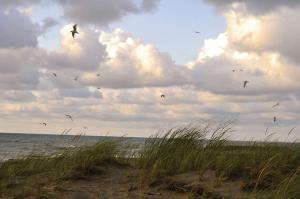Mercyhurst College Assistant Professor of Biology Steven Mauro, Ph.D., recently helped the college secure a $250,000 grant from the U.S. Environmental Protection Agency (EPA).
He and a team of Mercyhurst students have researched contaminants in Presque Isle State Park’s recreational waters since 2006. The grant will enable such research to continue.
“Over the course of the last five years, 26 students have done summer research projects,” Mauro said.
 Tyler Stauffer: Mercyhurst College received a $250,000 grant to research contaminants in Presque Isle State Park’s waters. Testing is done on Presque Isle Beaches One, Two, Six and 10.A major portion of the sizable grant is used to pay student salaries and purchase equipment the students need to conduct their research. The remainder of the money goes to giving the students opportunities to present their research at scientific meetings.
Tyler Stauffer: Mercyhurst College received a $250,000 grant to research contaminants in Presque Isle State Park’s waters. Testing is done on Presque Isle Beaches One, Two, Six and 10.A major portion of the sizable grant is used to pay student salaries and purchase equipment the students need to conduct their research. The remainder of the money goes to giving the students opportunities to present their research at scientific meetings.
“We do the research, but at the end of our process, we submit our data to the health professionals, and we provide suggestions on where contaminants might be coming from based on the data that we have,” Mauro said.
He and the students also offer possible solutions to the contamination based on their results.
The remediation plans provide research-based suggestions to government agencies and health officials.
Mauro explained what the students did during the water testing process.
“We started off trying to determine what’s in the waters in a faster way than it is normally done,” Mauro said.
Normally, water testing can take 24 hours or longer, which means that people may be swimming in potentially contaminated water for a day or more before anyone is aware of it.
During the water testing, “we look for pharmaceuticals that people may have flushed down the toilet” Mauro said, “along with agricultural contamination, such as estrogen given to cows and Diuron, a chemical which is a fertilizer, along with Fluoxetine, the active ingredient in anti-depressants.”
Some of these substances find their way into the lake because Erie’s wastewater treatment plants eliminate enviro-contaminants, such as bacteria and viruses, but treatment does not get rid of all the chemicals that find their way into the system.
Once the student researchers find the likely source of the contaminants, health officials use the research results to prevent that source from further accessing the waste treatment system.
Testing is done on Presque Isle Beaches One, Two, Six and 10. Beaches One and Two tend to be more contaminated than the others tested.
Mauro explained how Mercyhurst qualified for the EPA grant.
“We decided the project was doable and that we could fulfill all of the grant requirements,” he said. “We proposed a good project, and we know what we’re doing.”
